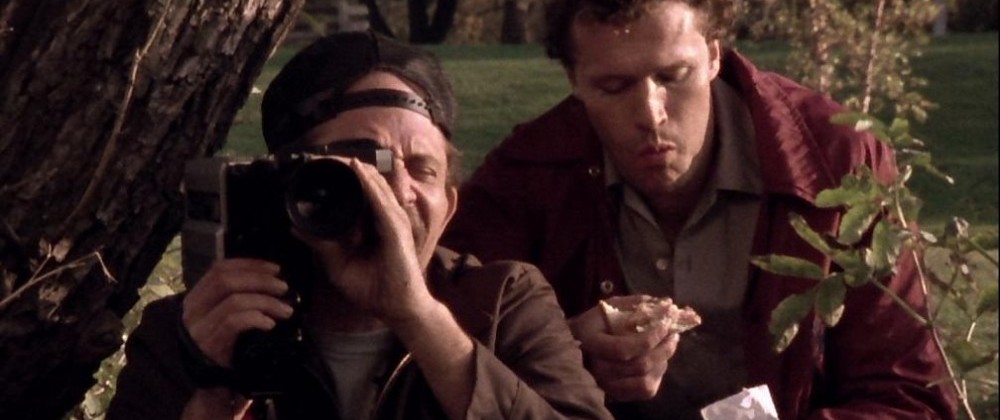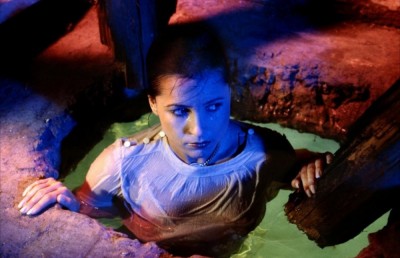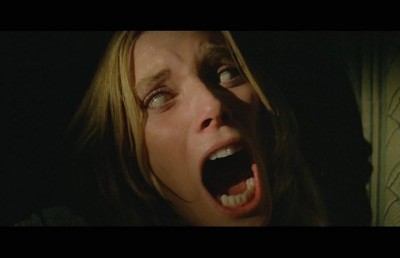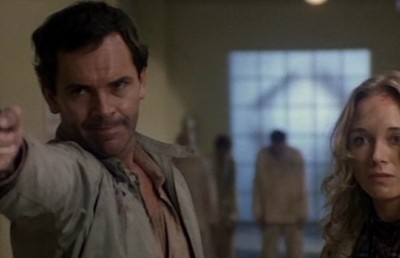Independent Horror Cinema
The Quick and the Good

During the Hollywood Studio period (roughly 1920 to 1950), the demarcation line between the majors and the independents was quite clear. The majors, the “Big Five” (Warners, MGM, RKO, Paramount, Fox) and “Little Three” (Columbia, Universal, United Artists), controlled production, distribution and exhibition and collected upwards of 95% of all box-office revenue. Independents such as Monogram, Republic, PCR, Tiffany and Grand National competed for the remaining percentages. Things have changed considerably today, but how does that saying go, “plus ca change, plus ca ….”
The major studios today, (Disney, Fox, Paramount, Warner Bros., Universal, MGM/UA, Columbia) are vastly diversified and tied to huge conglomerates who own or control the major theater chains. Today’s industry landscape is much more mercurial than in the past, with bankruptcies, buy outs and mergers continually shifting the terrain. For example, two independent companies, Miramax and New Line, were recently purchased by major companies Disney and Turner respectively. To confuse matters, some independent companies have a separate distribution arm to handle specialized markets. For example, Miramax has Dimension Films to distribute genre (horror) and New Line has Fine Line for arthouse films. The 1980’s saw a wave of independents come and go in this constant sea of change. The demarcation lines today may by less clear, but the schism between the major and independent studios remains. This article will point out some general differences between independent (indie) and major studio horror films, underline some trends in indie horror, and discuss some of its key films/figures.
Independents: $10,000 to $10,000,000
It is important to realize that there is a strong hierarchy among indies. The big brothers among the indies are: Miramax, New Line, Gramercy, Goldwyn, Sony and October. Independents range from large companies with diversified interests or auxiliary distribution arms (Miramax, New Line, Disney), to tightly-run businesses which function much like old Hollywood studios (Troma), to indies who produce films or videos exclusively for video release (Full Moon, Tempe Video Direct, Film Threat Video). The budget within this group can range from $10,000 to $10,000,000, which constitutes a more appreciable difference than a 30 or 40 million dollar difference between major studio productions.
To give you some examples, the recent Dimension Films release The Prophecy, (Gregory Widen, 1995, originally titled God’s Army) has an $8,000,000 budget, and Trimark’s Return of the Living Dead 3 (Brian Yuzna, 1992) a $2,000,000, while two of the more notorious underground horror films of recent years, German Jorg Buttgereit’s Nekromantik (1988) and Nekromantik 2 (1990) have a combined budget of $45,000. Some self-financed, shot-on-video products have budgets in the $5,000 to $10,000 range. These latter films are an offshoot of a horror fanzine revolution which has generated a new forum for ultra low-budget horror film/video production and distribution. Though this revolution suggests Walter Benjamin’s democratizing of art, the amateurish quality of the average product distributed through fan-journals makes them off-limits to even the most die-hard horror fans. But with new cable stations, pay-per-view, and improving video and television technology, the fan-journal/direct-to-video market may have a future yet.
Art vs. Commerce?
It may seem like a truism that horror thrives on the margins, beyond the fickle, censorious hands of major studios, but something does happen to the creative juices when the no-holds-barred horror imagination collides with major studio practices. Roy Frumkes, who has been involved in the horror/film industry from all sides, directing, producing, publishing and serving on the board of directors of the National Board of Review, has this to say concerning the horror scene:
A lot of the really strong horror films come from the indies, because that’s where you get the chance to do something radical. Majors have their own censorship internally. Directors do their strongest stuff before they go mainstream (Fangoria #88, p. 64).The following list of independently made virgin horror successes confirms Frumkes words: Night of the Living Dead (George Romero, 1968), The Last House on the Left (Wes Craven, 1972), The Texas Chainsaw Massacre (Tobe Hooper, 1974), Halloween (John Carpenter, 1978), Evil Dead (Sam Raimi, 1983), Re-animator (Stuart Gordon, 1985), and Society (Brian Yuzna, 1985).
The beauty of these first time horror classics is in their primal simplicity and single-minded directness, uncluttered by reflexivity or critical or commercial pressure. A major studio’s corporate mentality can short-circuit these qualities. On the positive ledger, a major studio can easily finance a project, supply studio facilities and assure major distribution, but at a price. Many directors have noted the creative sacrifices that come with major studio financial and distribution security (Sam Raimi, John Carpenter, Jeff Burr, Dario Argento to name only a few). William Peter Blatty’s experience with The Exorcist 3 (1990) illustrates the point well. Blatty’s intentions were to make the third installment in the Exorcist series an unfashionably literate and low-key horror film. Fox, unhappy with the final product, dangled 4 million dollars in front of Blatty to shoot a concluding exorcism scene. The result is an ending which feels separate from the rest of the film and destroys the previously structured ambivalent, claustrophobic horror.
How many major studio released horror films of recent years have challenged both the staid horror junkie and mass audience in terms of intensity, viscerality or originality? One would have to go back to 1980 (The Shining) or 1979 (Alien). The ground breaking horror films of the last ten years have come from the independents (Re-animator, Henry: Portrait of a Serial Killer (John McNaughton, 1986), Evil Dead 2 (Sam Raimi, 1987), Nekromantik, Brain Dead (aka Dead Alive, Peter Jackson, 1992), Dellamorte Dellamore (Michelle Soavi, 1994). It may seem strange to think of horror films in these terms, but the dichotomy between majors and indies often suggests the venerable “art” versus “industry” issue. The level of creative interference seems to rise equal to the level of financial assurance. The higher the investment, the higher the compromises. Compromises which usually revolve around questions of tone (more upbeat, less intense), subject matter (less risky) and style (less arty). In fact, several recent indie horror films which have garnered critical and fan acceptance straddle the line between commercial and art film: Henry: Portrait of a Serial Killer, Dust Devil (Richard Stanley, 1992), Nekromantik, Der Todesking (The Death King, Jorg Buttgereit, 1990), In a Glass Cage (Augustín Villaronga, 1988), Jack Be Nimble (Garth Maxwell,1992), Dellamorte, Dellamore, Nadja (Michael Almereyda, 1995), and The Addiction (Abel Ferrera, 1995). These films share formal and thematic qualities that have more in common with art cinema than popular cinema: stylized mise-en-scene, ambiguous narratives, symbolic imagery, complex morality. Although Dario Argento can not be considered an independent in his native country, this trend toward an art cinema aesthetic has been greatly influenced by his excessive, uncompromising style (elaborate set-pieces, flamboyant camera movements that go beyond narrative purpose, stylized mise-en-scene).
Trends and Differences
Indie horror films are often characterized by a refusal to make pat, simplistic moral judgements on their horrific creations (Henry and Nekromantik are exemplary here). The indies seem to be aligned with philosopher Mortimer Adler’s position in Art and Prudence: A Study in Practical Philosophy, that artworks themselves can not be moral, only humans can, and that the process of education and sermonizing is best left to the non-art world. However, the thought that ghastly film acts not be judged and punished within the body of the text frightens the status quo. And the majority of today’s public seems to side with the cautionary status quo, which is one reason why indie horror can never match the commercialism of major releases. I would argue, however, that because of this indie horror films force spectators to make moral judgements and instill in them a sense of self-responsibility. Moral thinking is cultivated through thinking, and not by having easy solutions provided for us.
A welcome trend which aligns itself with this more complex depiction of morality is the influence of horror writer H.P. Lovecraft on recent indie directors: Brain Yuzna/Necronomicon (1993), Dan O’Bannon/The Resurrected (1992), Carpenter/In the Mouth of Madness (1994), Michele Soavi/The Church (1990) and The Sect (1992), Mariano Baino/Dark Waters (1994). If anything, Lovecraft serves as a contrast to Stephen King’s black & white moral universe (depicted most blatantly in the telefilm The Stand, 1994.)
In relation to this, some of the better recent indie horror films have explored religion as a source/subject for horror: The Prophecy, The Sect, The Church, Cronos (Guillermo Del Toro, 1992), Dark Waters and Dust Devil. Religion has provided great fodder for horror films since 1931 (Dracula, Frankenstein). The trend spiralled upwards with the successes of The Exorcist (William Friedkin, 1973), The Antichrist (Alberto De Martino, 1974) and The Omen (Richard Donner, 1976), but rescinded during the slasher and body horror exploits of the late seventies and eighties. But religion in horror has seen a resurrection in recent years. In the Italian film Dark Waters, Baino uses the religious iconography he saw as a child in the churches of Naples as a starting point for a nightmarish blend of the demonic and the holy. One of the film’s central visual motifs revolves around the ambivalent mixture of horror and beauty in Christian iconography. We see it throughout the film’s mise-en-scene: the gorgeous yellow-gold lighting of the huge crosses; the candle-lit catacombs; the murders depicted in the frescoes and paintings; and the crosscutting between flagellation and murder.
One of the best American indies of late, The Prophecy, presents a fascinatingly ambivalent depiction of religion. In The Prophecy, the creation of mankind triggers a civil war in heaven between angels who have become jealous and resentful over their demotion, and those remaining loyal to God. The leader of the rebel angels, Gabriel (sublimely played by Christopher Walken) comes to earth to attain the final piece necessary to ensure victory: the evil soul of a recently deceased army General. Simon, a good angel, gets to the soul first and “hides” it in the body of a living girl. This triggers a chase between Gabriel and his minions on one side, and a schoolteacher, an ex-priest-turned cop, and Lucifer himself on the other. The plot is accurately described by producer Joel Soisson as a “theological Terminator.” The literate and thematically rich script takes innovative liberties with conventional plot (for example, four heroes instead of one). The visually stylish film blends horror iconography with a decidedly western landscape. Gabriel looks like a celestial gunslinger, tall, lean with jet black hair and clothes. The town’s local schoolmarm Katherine (Virginia Madsen also with hair dyed black) plays off Gabriel’s westerner image. Though the film concludes with a blunt reaffirmation of Christian faith, the sinister aspects of Christianity which precede it leave a far stronger impression. For example, Gabriel referring to pre-mankind as “before the monkeys”; angels who are resentful for having to do God’s “dirty work”; the depiction of heaven as a battlefield; an apparently indifferent God; and a Christ-like Lucifer who turns out to be one of the film’s heroes.
As one goes lower down the budget of indie horror, religion disappears and is replaced by secular, non-supernatural “reality horror.” Some of the more uncompromising (and consequently marginalized) indie horror directors share a horrific vision of young urban alienation which is a dark, alter-ego to the fluff-angst found in recent serio-comedies such as Singles (Cameron Crowe, 1992), Reality Bites (Ben Stiller, 1994) and Clerks (Kevin Smith, 1994). In particular, Ohio filmmaker Jim Van Bebber’s feature Deadbeat at Dawn (1988) and his short My Sweet Satan (1993), and Buddy Giovinazzo’s Combat Shock [aka American Nightmare] (1987) form a remarkable urban-misery trilogy which collectively depict some of the major social sores facing young people today: unemployment, street gangs, crime, violence, drugs, and cultism.
Strategies: Franchises and Auteurs
Films must find ways to survive in a market dominated by the major studios. There are several strategies indies have used to compete with the huge budgets, production values and star appeal of the major studio films. The route taken by many since the eighties is to make sequels based on “franchiseable” products. These are films which, through recurring characters and/or recognizable titles, have a built-in market and hence don’t require mega-promotion. All of the following films have had at least two sequels: Texas Chainsaw Massacre, Halloween, Phantasm (Don Coscarelli, 1979), Prom Night (Paul Lynch, 1980), Friday the 13th (Sean Cunnigham, 1980) (Indie New Line recently purchasing the rights for this series from major player Paramount), The Howling (1981), Trancers (1984), Silent Night, Deadly Night (1984), Nightmare on Elm Street (1984), Witchboard (1985), Toxic Avenger (1985), Hellraiser (1987), Pumpkinhead (1988), Maniac Cop (1988), Witchcraft (1988), Puppetmaster (1989), Subspecies (1990), Warlock (1991), Leprechaun (1992), ad infinitum. Though there are the odd pleasant surprises, this onslaught of sequels from indies has disheartened many horror fans.
However, other indie filmmakers differentiate their product through the frank treatment of taboo subject matters (sex, violence, morality), and make films which have little aspiration for mainstream acceptance. You may have to look hard, but innovative, transgressive horror is being made. At the leading edge of transgressive imagery, and definitely not to everyone’s taste, is director Jorg Buttgereit, the master of up-close death. Many indie films have broached the taboo area of necrophilia –Re-animator, Return of the Living Dead 3, Brain Dead, Henry: Portrait of a Serial Killer, Dellamorte Dellamore– but none to the extreme of Buttgereit’s films. His bleak, grotesque films have a clinical poeticism which makes their appeal hard to reconcile. Nekromantik, Buttgereit’s most notorious film, was described by John Waters as “the first erotic film for necrophiles.” The film’s staggering conclusion is by far the most literal equation of orgasmic death ever committed to the screen. Der Todesking, Buttgereit’s second feature, achieves a far more emotional depiction of nihilism without Nekromantik’s high blood count.
On a more mainstream front, horror fans can look to Italy’s two rising stars, Michele Soavi and Mariano Baino. In the tradition of Mario Bava and Dario Argento, Soavi and Baino have put fear and style back into the genre. Dark Waters, made amid the recent political turmoil in Russia, is Baino’s first feature film after the impressive short Caruncula (1993), and one of the more startling visual horror treats of recent years. In light of the annoying humor prevalent in the glut of “franchiseable” products, the straight-for-the-jugular approach of Italian horror is a welcome relief. Soavi’s latest film Dellamorte Dellamore (The Cemetery Man in North America) gets my vote for the most innovative and impressive horror release of recent years. Dellamorte Dellamore clearly marks Soavi’s maturation and separation from former producer-mentor Dario Argento. Like the works of Jorg Buttgereit but from a metaphorical, lyrical perspective, Dellamorte Dellamore (literally of death, of love) deals with death and impossible love. Cemetery custodian Francesca Dellamorte and his dim-wit sidekick Gnaghi, guard the outside world from “returners,” the dead who return to life on their seventh night of burial. In Dellamorte Dellamore, a zombie film that is part tragedy and part parable, the cemetery functions as a microcosm for the decay of Italian society. It has elements in common with the Italian horror film, such as a dominant soundtrack and stylized use of color, but adds an aspect virtually absent from the Italian horror film: devilishly black humor.
Another beacon in the indie horror scene is Richard Stanley, a former music video director who has made two highly personal horror films, Hardware (which can also be labelled cyperpunk, 1990) and Dust Devil, which assume a nihilism and bleakness not found in major studio products. The low-budget Hardware was a commercial success but Dust Devil has yet to find a major audience, which is unfortunate considering the inspired nature of this work. Stanley’s eclectic influences, ranging from Andrei Tarkovsky, to Hammer films, to Dario Argento, assures that his horror films will be anything but conventional. His mise-en-scene, choice of locations, and despairing thematics combine to form a claustrophobic, “cul-de-sac” aesthetic. The futuristic Hardware is set mainly in a small high-rise apartment, which becomes the site for a cat and mouse game between its tenant and a killer android. Dust Devil, set in the vast expanse of the Namibian desert, achieves an equally claustrophobic aesthetic through the continual dust that fills the frame, a color schema which collapses sky and desert, downward craning camera movements, and an omnipotent, shape-shifting serial killer. After a decade of mute or comic one-line spouting monsters, it’s a pleasant change to have a metaphysical killer who raises the stakes with lines like, “There’s no good or evil, just spirit and matter!”
A final indie film which merits attention is Jack Be Nimble, the New Zealand feature film debut of writer-director Garth Maxwell. At under one million dollars, the film should be an inspiration to other low-budget filmmakers and proves that horror can be a venue for serious subtext and social criticism. The film weaves themes of child abuse and alienation into a symbol-laden, visually stylish, psychic horror film. It begins audaciously with a speechless four minute sequence, which shows a young boy (Jack) and girl (Dora) abandoned by their mother and subsequently adopted by separate families. The film cleverly crosscuts between the two families to contrast the varying treatment the children receive (abuse/indifference). A close-up of an ornamental pig on Dora’s birthday cake cuts to a real pig on a farm miles away, which Jack is forced to watch slayed. An overhead shot looking down through the hanging pig’s ears to the blood-filled bucket dissolves to an overhead shot of the red icing on Dora’s cake. The film never matches this great opening sequence, but it is an ambitious, assured debut feature.
Even with the curse of sequels, today’s indie horror scene is the strongest its been since the early seventies. The healthy mix of first-time directors (Gregory Widen, Guillermo del Toro, Mariano Baino, Garth Maxwell), relative newcomers (Michele Soavi, Peter Jackson, Jorg Buttgereit, Richard Stanley, Jim Van Bebber) and veterans (John Carpenter, Wes Craven, Abel Ferrara, Stuart Gordon, Frank Henenlotter, Brian Yuzna) augurs well for the future. Horror films don’t require big budgets; neither should they, since the horror film audience is constant and loyal, but rarely huge (by Hollywood mega standards). It’s also a fact that the more visceral , explicit, and intense the imagery becomes, the smaller the audience. Thankfully, the recent trend toward intelligent, thoughtful scripts that take their horror seriously should appease both horror fans and mainstream audiences.
WORKS CITED
Adler, Mortimer. Art and Prudence: A Study in Practical Philosophy, 1937
Fangoria, #88, p. 64
P.S. This article was first published in a French translation in Séquences #181, Dec./Jan. 1995.














